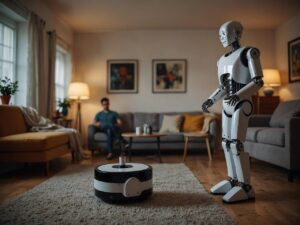Elon Musk is no stranger to ambitious projects—from electric cars at Tesla to interplanetary travel with SpaceX. Now, he’s setting his sights on what could be his most disruptive venture yet: humanoid robots.
At Tesla’s AI Day 2021, Musk unveiled Optimus, a humanoid robot designed to perform tasks ranging from household chores to industrial labor. But beyond being a high-tech novelty, Optimus could reshape economies, redefine work, and even alter human society.
The question is: Is the world ready for a robot revolution?


1. What is the Tesla Optimus Robot?
Design & Capabilities
-
Human-like form: 5’8”, 125 lbs, with fluid movements.
-
AI-powered brain: Runs on Tesla’s Dojo supercomputer, using the same AI as self-driving cars.
-
Sensors & Cameras: 360-degree vision for navigation and task execution.
-
Versatile hands: Designed for precision tasks like handling tools or cooking.
Unlike rigid factory robots, Optimus is built for real-world adaptability—capable of functioning in homes, offices, and even outer space.
How Does It Learn?
-
Neural networks trained via real-world and simulation data.
-
Continuous improvement through user interactions (like Tesla’s Full Self-Driving system).
-
Potential for third-party apps, allowing customization for different jobs.
2. How Will Robots Change the Workforce?
The Good: Efficiency & Safety
-
Dangerous jobs (construction, mining, firefighting) could be handled by robots.
-
24/7 productivity without fatigue in factories and warehouses.
-
Elderly & disability care – Robots could assist with mobility and daily tasks.
The Bad: Job Displacement
-
30% of current jobs (especially manual labor) could be automated by 2030 (McKinsey).
-
Economic inequality may widen if robot ownership is limited to corporations and the wealthy.
-
Universal Basic Income (UBI) may become necessary to offset job losses.
New Opportunities
-
Robot maintenance & programming jobs will surge.
-
Creative & service roles (art, therapy, education) will gain value.
3. Real-World Applications: Beyond Sci-Fi
At Home
-
Cooking, cleaning, and childcare assistance.
-
Security monitoring with facial recognition.
In Healthcare
-
Surgical assistance with precision beyond human hands.
-
Companionship for seniors to combat loneliness.
In Space
-
Mars colonization – Robots could build habitats before humans arrive.
-
Repairing satellites in zero-gravity environments.
4. Ethical & Societal Concerns
AI Safety & Control
-
What if a robot misinterprets commands and causes harm?
-
Could AI develop unintended behaviors over time?
Privacy Risks
-
Always-on cameras and microphones raise surveillance fears.
-
Who owns the data collected by household robots?
Legal & Moral Questions
-
Robot rights? If AI becomes sentient, should it have protections?
-
Who’s liable? If a robot injures someone, is Tesla, the owner, or the AI responsible?
5. The Future: Utopia or Dystopia?
Optimistic View
-
A world of leisure where humans focus on creativity and relationships.
-
End of menial labor, leading to higher quality of life.
Pessimistic View
-
Mass unemployment and social unrest.
-
AI surpassing human control (a la Terminator scenarios).
Middle Ground?
-
Regulated adoption with strong AI ethics laws.
-
Gradual integration to allow society to adapt.
Conclusion: Are We Ready?
Elon Musk’s Optimus robot isn’t just another gadget—it’s a fundamental shift in human civilization. The benefits could be enormous, but the risks demand careful regulation and ethical foresight.
The real question isn’t if robots will change humanity—it’s how we’ll manage that change.
Will we build a future of shared prosperity with machines, or will we face unintended consequences? The answer depends on the choices we make today.
Tesla’s Robot Future: How Optimus Could Transform Our World
Introduction
Elon Musk, the visionary behind Tesla and SpaceX, is now steering humanity toward another groundbreaking frontier: humanoid robots. Tesla’s Optimus (Tesla Bot) represents more than just advanced automation—it could redefine labor, daily life, and even space exploration.
This article explores:
✔ What is the Tesla Optimus robot?
✔ How will it change industries?
✔ The ethical and economic implications
✔ What the future holds
1. What is Tesla’s Optimus Robot?
Design & AI Capabilities
-
Human-like form: 5’8” tall, 125 lbs, designed for agility.
-
AI-powered brain: Uses Tesla’s Full Self-Driving (FSD) neural networks and Dojo supercomputer for learning.
-
Advanced sensors: Cameras, ultrasonic sensors, and actuators for real-time environmental awareness.
-
Versatile hands: Capable of delicate tasks like using tools or handling groceries.
Unlike traditional industrial robots, Optimus is built for real-world adaptability, meaning it can function in homes, factories, and even on Mars.
How Does It Learn?
-
Neural network training: Learns from simulations and real-world interactions.
-
Continuous improvement: Like Tesla’s cars, it gets smarter over time via software updates.
-
Potential for customization: Users may install specialized task modules (e.g., cooking, cleaning, caregiving).
2. How Will Tesla Robots Change Industries?
A. Workforce & Labor
✅ Pros:
-
Eliminates dangerous jobs (construction, mining, firefighting).
-
Reduces repetitive labor in factories and warehouses.
-
Assists in healthcare (elderly care, patient lifting, surgery).
❌ Cons:
-
Job displacement – Millions of manual labor jobs could disappear.
-
Economic inequality – Companies that own robots may gain excessive power.
B. Everyday Life
-
Household chores: Cooking, cleaning, and home maintenance.
-
Personal assistant: Grocery shopping, childcare support, and security monitoring.
-
Disability aid: Helping people with mobility issues live independently.
C. Space Exploration
-
Mars colonization: Robots could build habitats before humans arrive.
-
Space station maintenance: Repairing equipment in hazardous environments.
3. Ethical & Societal Concerns
A. AI Safety & Control
-
Could robots malfunction and harm humans?
-
What if AI develops unpredictable behavior?
-
Who is responsible if a robot causes damage?
B. Privacy Risks
-
Always-on cameras & microphones could lead to surveillance concerns.
-
Data security: Who owns the information collected by robots?
C. Economic & Legal Challenges
-
Universal Basic Income (UBI): Will governments need to support displaced workers?
-
Robot rights: If AI becomes sentient, should robots have legal protections?
-
Regulation: How should governments control robot use?
4. The Future: Utopia or Dystopia?
Optimistic Scenario
-
Humans focus on creativity, art, and innovation.
-
Robots handle labor, reducing work hours and improving quality of life.
-
Space colonization becomes feasible with robotic labor.
Pessimistic Scenario
-
Mass unemployment and social unrest.
-
AI surpasses human control (a “Terminator” risk).
-
Corporations monopolize robot labor, increasing inequality.
Most Likely Outcome?
-
Gradual integration with regulations.
-
New job markets in robot maintenance & AI oversight.
-
A mix of benefits and challenges, requiring careful policy.
Conclusion: Are We Ready for a Robot Future?
Tesla’s Optimus isn’t just another tech gadget—it’s a societal game-changer. While the benefits (safer jobs, more leisure time, space exploration) are immense, the risks (job loss, AI ethics, privacy) demand urgent discussion and regulation.
The key question isn’t if robots will reshape humanity—it’s how we manage the transition. Will we build a future of shared prosperity with machines, or will we face unintended consequences?
The answer depends on the choices we make today.
Frequently Asked Questions About Tesla’s Optimus Robot
1. What can Tesla’s Optimus robot actually do?
Optimus is designed to perform repetitive, dangerous, or mundane tasks like household chores (cleaning, cooking), factory labor, elderly care, and even space construction. Its AI allows it to learn new tasks over time, and its human-like hands enable delicate object manipulation.
2. Will humanoid robots like Optimus take human jobs?
Yes, but the impact is nuanced:
-
High-risk jobs (mining, welding) may be fully automated.
-
New tech jobs (robot maintenance, AI training) will emerge.
-
Creative/service roles (healthcare, education, arts) will remain human-dominated.
Studies suggest 30% of current jobs could be automated by 2030, requiring workforce adaptation.
3. How safe is the Tesla robot around humans?
Tesla claims Optimus will have multiple safety protocols:
-
Collision-avoidance sensors (like those in self-driving cars).
-
Limited force to prevent accidental harm.
-
Remote monitoring/shutoff capabilities.
However, real-world safety testing is still ongoing.
4. What are the biggest ethical concerns?
Key debates include:
-
Privacy: Always-on cameras/mics in homes.
-
AI autonomy: Could it act unpredictably?
-
Job loss: Will governments need policies like Universal Basic Income (UBI)?
-
Liability: Who’s responsible if a robot causes harm?
5. When will Optimus be available to the public?
Elon Musk estimates limited production by 2025, with mass-market rollout later. Current prototypes are being tested in Tesla factories. Pricing is unconfirmed but aims to be “affordable” (potentially under $20,000).












